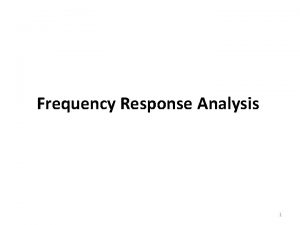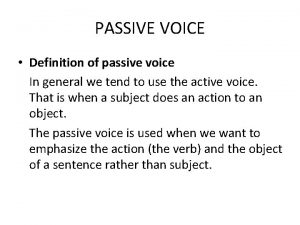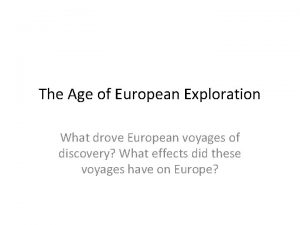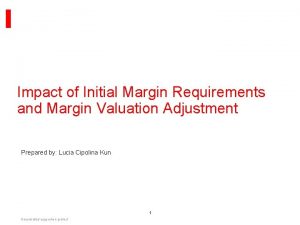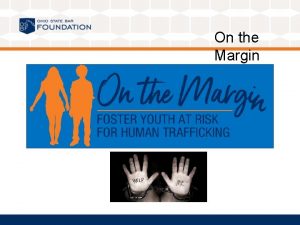Chapter 15 Margin Review Questions What drove European









- Slides: 9

Chapter 15 Margin Review Questions

What drove European involvement in the world of Asian commerce? • Desire for tropical spices, Chinese silk, Indian cottons, rhubarb, emeralds, rubies, and sapphires • Recovery of European civilization following the disaster of the Black Death was a factor • Resentment of the Muslim monopoly on the flow of Indian Ocean products to Europe • Need to secure gold and silver to pay for Asian spices and textiles

How did the Portuguese, Spanish, Dutch, and British initiatives in Asia differ from one another? • Portuguese sought to set up a trading post empire that controlled the trade routes of the Indian Ocean. • Spanish established colonial rule over the Philippine Islands. - they drew on their experience in the Americas, converting most of the population to Christianity, ruling over the islands directly, and setting up large landed estates owned by Spanish settlers.

• The Dutch and British organized their Indian Ocean ventures through private trading companies. • These trading companies obtained government charters granting them trading monopolies, the power to make war, and the right to govern conquered peoples. • Dutch seized control of some of the Spice Islands, while the British set up trading centers in India by securing the support of the Mughal Empire or of local authorities.

What was the world historical importance of the silver trade? • First direct and sustained link between the Americas and Asia, and it initiated a web of Pacific commerce that grew steadily over the centuries. • It became a key commodity driving longdistance trade and offered the Europeans a product that they could produce that was also in demand elsewhere in the world.

What roles did Europeans and Africans play in the unfolding of the Atlantic slave trade? • European demand for slaves was clearly the chief cause of the trade. • Europeans tried to exploit African rivalries to obtain slaves at the lowest possible cost, and the firearms that they funneled into West Africa may well have increased the warfare from which so many slaves were derived.

• From the point of initial capture to sale on the coast, the slave trade was normally in African hands. African elites and merchants secured slaves and brought them to the coast for sale to Europeans waiting on ships or in fortified settlements.

In what different ways did the Atlantic slave trade transform African societies? • Africa became a permanent part of an interacting Atlantic world, both commercially and demographically. • It slowed Africa’s population growth at a time when the populations of Europe, China, and other regions were expanding.

• The slave trade in general stimulated little positive economic change in Africa and led to economic stagnation. • Some larger kingdoms, such as Kongo and Oyo, also slowly disintegrated because of the slave trade. • But in other regions, like Benin and Dahomey, African authorities sought to take advantage of the new commercial opportunities to manage the slave trade in their own interests.
 What drove european involvement in asian commerce
What drove european involvement in asian commerce Phase margin
Phase margin Relative frequency formula
Relative frequency formula Chapter review motion part a vocabulary review answer key
Chapter review motion part a vocabulary review answer key What drove martin luther to write the 95 theses
What drove martin luther to write the 95 theses The band the night they drove old dixie down
The band the night they drove old dixie down Every complete sentence contains two parts a subject and a
Every complete sentence contains two parts a subject and a Janie drove from barnsley to york
Janie drove from barnsley to york Why did brian save the pieces of aluminum from the fuselage
Why did brian save the pieces of aluminum from the fuselage The boy writes poems passive voice
The boy writes poems passive voice


